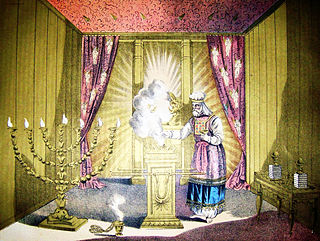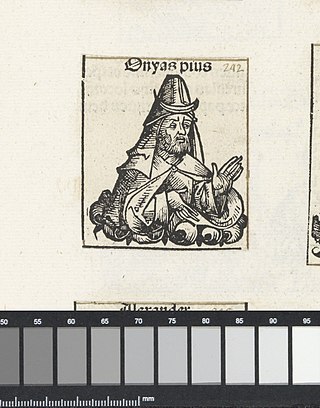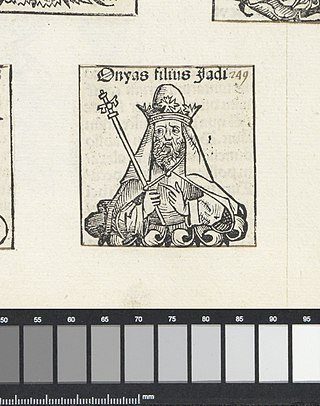Related Research Articles

The Maccabees, also spelled Machabees, were a group of Jewish rebel warriors who took control of Judea, which at the time was part of the Seleucid Empire. They founded the Hasmonean dynasty, which ruled from 167 to 37 BCE, being a fully independent kingdom from 104 to 63 BCE. They reasserted the Jewish religion, expanded the boundaries of Judea by conquest, and reduced the influence of Hellenism and Hellenistic Judaism.

The Hasmonean dynasty was a ruling dynasty of Judea and surrounding regions during the Hellenistic times of the Second Temple period, from c. 140 BCE to 37 BCE. Between c. 140 and c. 116 BCE the dynasty ruled Judea semi-autonomously in the Seleucid Empire, and from roughly 110 BCE, with the empire disintegrating, Judea gained further autonomy and expanded into the neighboring regions of Perea, Samaria, Idumea, Galilee, and Iturea. The Hasmonean rulers took the Greek title basileus ("king") as the kingdom became a regional power for several decades. Forces of the Roman Republic intervened in the Hasmonean Civil War in 63 BCE and made it into a client state, marking the decline of Hasmonean dynasty; Herod the Great displaced the last reigning Hasmonean client-ruler in 37 BCE.
2 Maccabees, also known as the Second Book of Maccabees, Second Maccabees, and abbreviated as 2 Macc., is a deuterocanonical book which recounts the persecution of Jews under King Antiochus IV Epiphanes and the Maccabean Revolt against him. It concludes with the defeat of the Seleucid Empire general Nicanor in 161 BC by Judas Maccabeus, the leader of the Maccabees.

Zadok, also spelled Ṣadok, Ṣadoc, Zadoq, Tzadok or Tsadoq, was a Kohen (priest), biblically recorded to be a descendant from Eleazar the son of Aaron. He officed and was the High Priest of Israel during the reigns of David and Solomon kings of Israel. He aided King David during the revolt of his son Absalom, was subsequently instrumental in bringing Solomon to the throne and officiated at Solomon's coronation. After Solomon's building of the First Temple in Jerusalem, Zadok was the first High Priest to serve there.

In Judaism, the High Priest of Israel was the head of the Israelite priesthood. He played a unique role in the worship conducted in the Tabernacle and later in the Temple in Jerusalem, as well as in some non-ritual matters. Like all priests, he was required to be descended from Aaron. But unlike other priests, the high priest followed more restrictive laws, wore unique priestly garments, and was the only priest allowed to perform certain ceremonies.
Leontopolis is the Greek name of a city that may correspond to either the modern area of Tell el Yehudiye or Tell el-Yahudiya. It was an ancient city of Egypt in the 13th nome of Lower Egypt, on the Pelusiac branch of the Nile. This site is known for its distinctive pottery known as Tell el-Yahudiyeh Ware.
Onias IV was the son of Onias III and the heir of the Zadokite line of High Priests of Israel. He built a new Jewish temple at Leontopolis in Ptolemaic Egypt where he reigned as a rival High Priest to the hierarchy in Jerusalem. While he never gained leadership in Judea, he still held influence in Egypt; the territory most heavily populated by Jews was called the Land of Onias in reference to his influence.
Onias may refer to:
Jason was the High Priest of Israel from around 175 BCE to 171 BCE during the Second Temple period of Judaism. He was of the Oniad family and was brother to Onias III, his predecessor as High Priest. Josephus records that his name was originally Jesus or Joshua before he changed it.
Menelaus was High Priest in Jerusalem from about 172 BC to about 161 BC. He was high priest at the beginning of the Maccabean revolt (167-160). He was the successor of Jason, the brother of Onias III.

Onias III, son of Simon II, was Jewish High Priest during the Second Temple period. He is described in scriptures as a pious man who opposed the Hellenization of Judea. He was succeeded by his brother Jason in 175 BCE.
The Land of Onias is the name given in Hellenistic Egyptian, Jewish, and Roman sources to an area in ancient Egypt's Nile Delta where a large number of Jews settled. The Land of Onias, which included the city of Leontopolis, was located in the Heliopolite Nome.

Onias I was the son of the Jaddua mentioned in Nehemiah. According to Josephus, this Jaddua is said to have been a contemporary of Alexander the Great. I Maccabees regards Onias as a contemporary of the Spartan king Areus I. "Josephus is ... mistaken in placing it in the time of Onias III instead of Onias I, who was high priest c. 300 B.C. ."

Onias II was the son of Simon I. He was still a minor when his father died, so his uncle Eleazar, and whom after, the latter's uncle Manasseh, officiated as high priests before Onais himself succeeded to that dignity. According to Josephus, he was a covetous man and of limited intelligence, whose refusal to pay the twenty talents of silver which every high priest was required to pay to Ptolemy III Euergetes, the King of Egypt threatened to imperil both the high priest and the people. The impending disaster was averted by Onias’ nephew Joseph, son of Tobias, who, having friendly relations with the Egypt court, managed to conciliate Ptolemy. Onias is said to have died, almost simultaneously with his nephew Joseph, during the reign of Seleucus IV Philopator, hence about 181 BC. His son, Simon II assumed the high priestly office after the demise of his father.
The Book of Sirach, also known as The Wisdom of Jesus the Son of Sirach or Ecclesiasticus, is a Jewish literary work, originally written in Biblical Hebrew. The longest extant wisdom book from antiquity, it consists of ethical teachings, written approximately between 196 and 175 BCE by Yeshua ben Eleazar ben Sira, a Hellenistic Jewish scribe of the Second Temple period.

Simon II was a High Priest of Israel during the Second Temple period. He was the son of Onias II, and probably was succeeded by Onias III. There are two main sources that discuss Simon II: the Book of Sirach and possibly 3 Maccabees. Based on the Book of Sirach, Simon II was active at some point in the 190s BCE. If the reference to a High Priest Simon in 3 Maccabees is to the same person, then he was also active as High Priest in the 210s BCE as well. John J. Collins estimates his reign as 219–196 BCE for example, while Elias Bickerman suggests only that he served c. 190 BCE. He was possibly the same person as Simon the Just, although the historian Josephus thought this referred to Simon I instead.
Eleazar was a Jewish High Priest during the Second Temple period. He was the son of Onias I and brother of Simon I.
Jesus, son of Fabus, also known as Jesus, son of Phabet, Jesus son of Phiabi or Joshua ben Fabus, was a Jewish High priest in the 1st century BCE.
Simon, son of Boethus was a Jewish High priest in the 1st century BCE and father-in-law of Herod the Great. According to Josephus, he was also known by the name Cantheras. His family is believed to have been connected to the school of the Boethusians, and a family whose origins are from Alexandria in Egypt.
References
- ↑ Ingrid Hjelm (1 January 2000). The Samaritans and Early Judaism: A Literary Analysis. Continuum International Publishing Group. pp. 133–. ISBN 978-1-84127-072-2 . Retrieved 16 December 2012.
- ↑ H. T. Spence (2010). The Canon of Scripture. Foundations Bible College. pp. 148–. ISBN 978-1-882542-52-9 . Retrieved 16 December 2012.